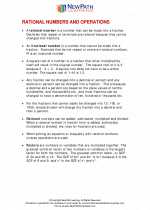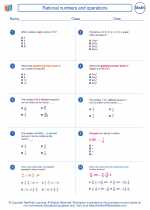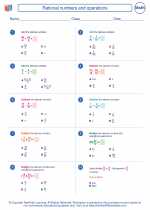Rational numbers and operations -> common denominator
Common Denominator
A common denominator is a shared multiple of the denominators of two or more fractions. When adding or subtracting fractions, it is essential to have a common denominator to combine the fractions accurately.
Finding the Common Denominator
To find the common denominator for a set of fractions, follow these steps:
- Identify the denominators of the given fractions.
- Find the least common multiple (LCM) of the denominators.
- The LCM will be the common denominator for the fractions.
Example:
Find the common denominator for the fractions 1/3 and 2/5.
Step 1: The denominators are 3 and 5.
Step 2: The LCM of 3 and 5 is 15.
Step 3: The common denominator for 1/3 and 2/5 is 15.
Using the Common Denominator
Once you have found the common denominator, you can use it to add or subtract the fractions. To do this, follow these steps:
- Express each fraction with the common denominator by multiplying the numerator and denominator by the same value.
- Perform the addition or subtraction on the numerators while keeping the common denominator the same.
Example:
Add the fractions 1/3 and 2/5 using the common denominator of 15.
Step 1: Express 1/3 as (1 * 5)/(3 * 5) = 5/15 and 2/5 as (2 * 3)/(5 * 3) = 6/15.
Step 2: 5/15 + 6/15 = 11/15.
The sum of 1/3 and 2/5 using the common denominator 15 is 11/15.
Study Guide
Here are some key points to remember about common denominators:
- A common denominator is necessary for adding or subtracting fractions.
- The common denominator is a multiple of the denominators of the given fractions.
- To find the common denominator, calculate the least common multiple (LCM) of the denominators.
- After finding the common denominator, use it to express the fractions and perform addition or subtraction.
Practice finding common denominators and using them to add or subtract fractions to strengthen your understanding of this concept.
Now that you have learned about common denominators, you can confidently work with fractions and perform operations on them accurately.
.◂Math Worksheets and Study Guides Eighth Grade. Rational numbers and operations

 Worksheet/Answer key
Worksheet/Answer key
 Worksheet/Answer key
Worksheet/Answer key
 Worksheet/Answer key
Worksheet/Answer key
